Fluoride for dental treatment
About Fluoride
Fluoride is a natural mineral. It is physiologically essential element required for the normal growth and development of human. Fluoride strengthens teeth and prevents caries. During pre eruptive or post eruptive stage of tooth development fluoride is incorporated in to the tooth and makes it more resistant to dental caries. The very initial stages of dental caries are healed by fluoride. Fluoride slowdowns the progress of dental caries by making the teeth less reactive to acid produced by bacteria. Fluoride also helps to reduce plaque accumulation in teeth.
Natural source and metabolism of fluoride
Fluoride are naturally exist in ground water. Leafy vegetables such as lettuce, cabbage, Brussels sprouts contain 2-20mg/g of fluoride. Dried tea leaves contain 100-400 ppm of fluoride. Dried fishes like mackerel, sardines, and salmon has more fluoride. Jowar, potatoes, banana, taro, cassava, yams has high fluoride level.Metabolism of fluoride
Fluoride is associated in stomach, lungs and intestine. Fluoride is stored in hard tissues like skeleton and dentition. It is excreted in urine, faeces, sweat, saliva and tears.Indication and time frame for fluoride treatment
Fluoride treatment is done in children at the age of 6 months to 16 years who are at high risk of dental caries and receives very low concentration of daily fluoride intake. Fluoride also benefits adults to prevent dental caries and plague. Disable children, patient receiving radiation therapy for head and neck, patient suffering from reduced salivary flow due to medications, patients with eating disorder, and patients with removable or fixed prosthesis receives fluoride treatment.Professional topical fluoride application
High concentration of fluoride is applied in the enamel during professional fluoride application. In this treatment fluoride can be applied in gel form or varnish form. For gel form fluoride application, the teeth are cleaned, polished and dried. Custom tray with 2gm of fluoride gel is dispensed. The upper and lower custom tray with gel is inserted simultaneously in patient’s mouth. The patient is asked to bite tightly for 4 minutes. Saliva should be ejected by suction as it should not be swallowed by patient. The patient is asked to expectorate saliva thoroughly after treatment. Instructions should be given not to eat, drink or rinse for 30 minutes. For fluoride varnish cleaning, polishing and drying the teeth is the initial step. A drop of varnish is taken in the brush and applied on the teeth surface. The patient is asked not to rinse drink and brush for the whole day.Self applied topical fluoride
Tooth paste contain 1000-1500 ppm of fluoride. Brushing twice a day with fluoride containing tooth paste prevent dental caries. Fluoride mouth rinse reduces caries by 20-50%. Fluoride mouth rinse are swished vigorously once in a day for one minute and spitted. It prevent bacterial metabolism and plague formation.Systemic fluoride
Systemic fluoride supplies a low concentration of fluoride over a long period of time. In this the fluoride is taken orally. It helps to incorporate fluoride in teeth before eruption while after tooth eruption fluoride contacts teeth directly through saliva. Community water fluoridation, salt fluoridation, milk fluoridation, fluoride tablets are some of systemic delivery of fluoride.Dental fluorosis
Excessive intake of fluoride during tooth development causes dental fluorisis. Opaque which patches, mottled enamel, hypoplasia are some of the clinical feature of dental fuorosis. It is treated by micro abrasion; veneer in severe cases crown is given to affected teeth.Conclusions
Fluoride is effective and safe agent to prevent and control dental caries. Fluoride dental treatment should be enhanced as it prevents dental caries in childhood. Awareness of fluoride treatment saves the teeth from irreversible damage caused by caries.[caption id="attachment_1548" align="alignleft" width="95"]
 Dr-Jovitta[/caption]
Author: Dr M. Jovitta, Pediatric /Preventive Dental Health Expert,
Jerush Dental & Facial Corrective Centre
Click to read Dr Jovitta's other blogs: "Why flossing is important" "Brushing Techniques" "Bad breath or Halitosis" "Smoking and Oral Health", Tooth replacement options for missing teeth" "Dental pain & Root canal Procedure", "Coronavirus (COVID-19), Symptoms and Prevention", "Gingivitis & Covid 19" "Oral cancer treatment" "Pericoronitis" "Teething" "Invisalign" "Dental jewels" "Warning signs your tongue gives you"
Dr-Jovitta[/caption]
Author: Dr M. Jovitta, Pediatric /Preventive Dental Health Expert,
Jerush Dental & Facial Corrective Centre
Click to read Dr Jovitta's other blogs: "Why flossing is important" "Brushing Techniques" "Bad breath or Halitosis" "Smoking and Oral Health", Tooth replacement options for missing teeth" "Dental pain & Root canal Procedure", "Coronavirus (COVID-19), Symptoms and Prevention", "Gingivitis & Covid 19" "Oral cancer treatment" "Pericoronitis" "Teething" "Invisalign" "Dental jewels" "Warning signs your tongue gives you" 
No Comments yet!